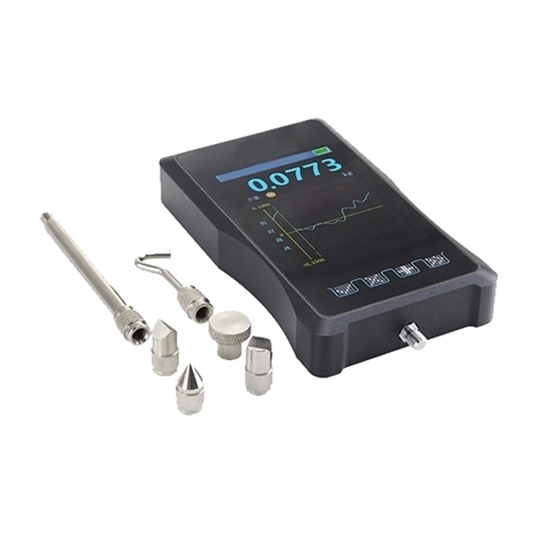
Handheld Digital Force Gauge, Push Pull, 0-500N
from
$325.38
Ex Tax: $325.38
- Stock: In Stock
- Model: RDDLZ-DY920
- Weight: 1.00
- SKU: RDDLZ-DY920
Available Options
Create unlimited custom product blocks and display them in accordions or tabs or open blocks. Each block can be assigned to all products at once or specific products according to advanced criteria.
Create unlimited custom product blocks and display them in accordions or tabs or open blocks. Each block can be assigned to all products at once or specific products according to advanced criteria.
The push-pull force gauge provides ±10N, ±20N, ±30N, ±50 N, ±100 N, ±200 N, ±300 N, and ±500 N. It supports multiple units of measurement such as Newtons, pounds, and kilograms. This foce gauge is designed with ergonomics in mind, ensuring easy handling and operation. Perfect for use in laboratory research, industrial settings, and quality control, the digital push-pull force gauge delivers accurate and reliable measurements to meet diverse requirements.
Specification & Feature
| MODEL | RDDLZ-DY920 |
| Range | 0-500N |
| Sample Rate | 2000Hz |
| Nonlinear | Better than 0.2% |
| Display Indexing | -99999~999999 |
| Signal Input | -15~15mV |
| Drift | Less than 20ppm |
| Built-in Battery | 3200mAh battery, battery life lasts for 10 hours when fully charged, low battery reminder |
| Sample Rate | 50Hz~12800Hz six levels adjustable |
| Display Interface | Real-time curves, historical curves/tables, peak-to-valley value display, and switchable landscape screen |
| Real-time Monitoring | Automatically capture peak-to-valley values and analyze sensor status |
| Set the Parameters | It can be backed up and restored, and restored with one click |
| Weightless Calibration | Simply enter the sensor parameters and the calibration is complete |
| Smart Sensors | Automatic calibration and modification of corresponding units and decimal points (using our TEDS smart sensors) |
| Connect to a Computer | The TYPE-C cable (RS485 optional) can be used to export force data directly with a PC |
| Interface Test Interface | View the debugging data of serial port and wireless communication |
| Data Retention | 200 sets of historical data of peak and valley values are saved, and they are not lost when the power is off |
| Alert Method | Upper limit alarm, lower limit alarm, peak-to-valley alarm, and automatic alarm for double the overrange |
| Capture Method | Threshold-Threshold, Threshold-Time, Threshold-Button |
| Built-in Sensors | Optional |
Dimension (mm)
Status Icon
| Icons Name | Icons | Description |
| Transient Regime | Force value instability: When the force value fluctuation is greater than the stability condition parameter, the icon will appear, indicatingl that the system is currently in an unstable state | |
| Zero Status | When the real time force value is less than the automatic zero range of the power, it will be zero and the icon will be displayed | |
| Wireless Commun Ication | When the handheld instrument wireless comunication is successful, the icon will be displayed and will disappear when there is no communication within 200 ms | |
| String Commun Ication | When the handheld instrumenti serial comunication is successful, the icon will be displayed and will disappear when there is no communication within 200 ms | |
| Alert status | When the handheld instrument reaches the set alarm condition,the icon will be displayed and the buzzer will work, when the real time force value exceeds the set range, the icon will be displayed at 50ms interval and the buzzer works for 100 ms interval |
Application
Tips: How to Select a Pull Push Force Gauge
When selecting a Pull Push Force Gauge, several factors should be considered to ensure it meets your specific measurement requirements. Some of the key factors to consider include:
- Measuring Range and Capacity: Determine the range of forces you need to measure, as well as the maximum capacity required for your applications. Ensure that the force gauge has a measuring range and capacity suitable for your intended use.
- Accuracy and Resolution: Look for a force gauge with high accuracy and resolution to ensure precise measurements. Consider the level of accuracy needed for your applications and choose a force gauge that meets those requirements.
- Display Type and Readability: Consider whether you prefer a digital or analog display for your force gauge. Digital displays typically offer easier readability and may provide additional features such as peak hold and real-time data logging.
Builder in Product TAB
NEW! Since Journal 3.2, the much improved T.A.B (Tabs Accordion Blocks) system supports the page builder inside the tab content. Unlimited Blocks, Tabs or Accordions with any HTML content or the builder interface (supporting custom rows/columns/modules) can be assigned to any individual product or to certain groups of products, like entire categories, brands, products with specific options, attributes, price range, etc.
You can indicate any criteria via the advanced product assignment mechanism and only those products matching your criteria will display the modules.
Also, any module can be selectively activated per device (desktop/tablet/phone), customer login status and other criteria. Imagine the possibilities.
